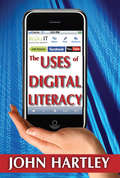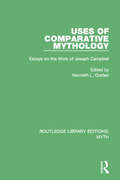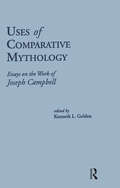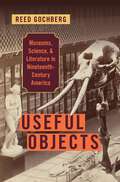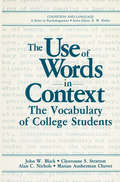- Table View
- List View
The Uses of Literature: Life in the Socialist Chinese Literary System
by Perry LinkWhy do people in socialist China read and write literary works? Earlier studies in Western Sinology have approached Chinese texts from the socialist era as portraits of society, as keys to the tug-of-war of dissent, or, more recently, as pursuit of "pure art." The Uses of Literature looks broadly and empirically at these and many other "uses" of literature from the points of view of authors, editors, political authorities, and several kinds of readers. Perry Link, author of Evening Chats in Beijing, considers texts ranging from elite "misty" poetry to underground hand-copied volumes (shouchauben) and shows in concrete detail how people who were involved with literature sought to teach, learn, enjoy, explore, debate, lead, control, and resist. Using the late 1970s and early 1980s as an entree to the workings of China's "socialist literary system," the author shows how that system held sway from 1950 until around 1990, when an encroaching market economy gradually but fundamentally changed it. In addition to providing a definitive overview of how the socialist Chinese literary system worked, Link offers comparisons to the similar system in the Soviet Union. In the final chapter, the book seeks to explain how the word "good" was used and understood when applied to literary works in such systems. Combining aspects of cultural and literary studies, The Uses of Literature will reward anyone interested in the literature of modern China or how creativity is affected by a "socialist literary system."
The Uses of Literacy: Aspects of Working-Class Life (Penguin Modern Classics)
by Lynsey Hanley Simon Hoggart Richard HoggartWhen a society becomes more affluent, does it lose other values? Are the skills that education and literacy gave millions wasted on consuming pop culture? Do the media coerce us into a world of the superficial and the material - or can they be a force for good? When Richard Hoggart asked these questions in his 1957 book The Uses of Literacy Britain was undergoing huge social change, yet his landmark work has lost none of its pertinence and power today. Hoggart gives a fascinating insight into the close-knit values of Northern England's vanishing working-class communities, and weaves this together with his views on the arrival of a new, homogenous 'mass' US-influenced culture. His headline-grabbing bestseller opened up a whole new area of cultural study and remains essential reading, both as a historical document, and as a commentary on class, poverty and the media.
The Uses of Literacy
by Richard HoggartThis pioneering work examines changes in the life and values of the English working class in response to mass media. First published in 1957, it mapped out a new methodology in cultural studies based around interdisciplinarity and a concern with how texts-in this case, mass publications-are stitched into the patterns of lived experience. Mixing personal memoir with social history and cultural critique, The Uses of Literacy anticipates recent interest in modes of cultural analysis that refuse to hide the author behind the mask of objective social scientific technique. In its method and in its rich accumulation of the detail of working-class life, this volume remains useful and absorbing.Hoggart's analysis achieves much of its power through a careful delineation of the complexities of working-class attitudes and its sensitivity to the physical and environmental facts of working-class life. The people he portrays are neither the sentimentalized victims of a culture of deference nor neo-fascist hooligans. Hoggart sees beyond habits to what habits stand for and sees through statements to what the statements really mean. He thus detects the differing pressures of emotion behind idiomatic phrases and ritualistic observances.Through close observation and an emotional empathy deriving, in part, from his own working-class background, Hoggart defines a fairly homogeneous and representative group of working-class people. Against this background may be seen how the various appeals of mass publications and other artifacts of popular culture connect with traditional and commonly accepted attitudes, how they are altering those attitudes, and how they are meeting resistance. Hoggart argues that the appeals made by mass publicists-more insistent, effective, and pervasive than in the past-are moving toward the creation of an undifferentiated mass culture and that the remnants of an authentic urban culture are being destroyed.In his introduction to this new edition, Andrew Goodwin, professor of broadcast communications arts at San Francisco State University, defines Hoggart's place among contending schools of English cultural criticism and points out the prescience of his analysis for developments in England over the past thirty years. He notes as well the fruitful links to be made between Hoggart's method and findings and aspects of popular culture in the United States.
The Uses of Literacy: Aspects Of Working-lass Life (Classics In Communication And Mass Culture Ser.)
by Richard HoggartThis pioneering work examines changes in the life and values of the English working class in response to mass media. First published in 1957, it mapped out a new methodology in cultural studies based around interdisciplinarity and a concern with how texts-in this case, mass publications-are stitched into the patterns of lived experience. Mixing personal memoir with social history and cultural critique, The Uses of Literacy anticipates recent interest in modes of cultural analysis that refuse to hide the author behind the mask of objective social scientific technique. In its method and in its rich accumulation of the detail of working-class life, this volume remains useful and absorbing.Hoggart's analysis achieves much of its power through a careful delineation of the complexities of working-class attitudes and its sensitivity to the physical and environmental facts of working-class life. The people he portrays are neither the sentimentalized victims of a culture of deference nor neo-fascist hooligans. Hoggart sees beyond habits to what habits stand for and sees through statements to what the statements really mean. He thus detects the differing pressures of emotion behind idiomatic phrases and ritualistic observances.Through close observation and an emotional empathy deriving, in part, from his own working-class background, Hoggart defines a fairly homogeneous and representative group of working-class people. Against this background may be seen how the various appeals of mass publications and other artifacts of popular culture connect with traditional and commonly accepted attitudes, how they are altering those attitudes, and how they are meeting resistance. Hoggart argues that the appeals made by mass publicists-more insistent, effective, and pervasive than in the past-are moving toward the creation of an undifferentiated mass culture and that the remnants of an authentic urban culture are being destroyed.In his introduction to this new edition, Andrew Goodwin, professor of broadcast communications arts at San Francisco State University, defines Hoggart's place among contending schools of English cultural criticism and points out the prescience of his analysis for developments in England over the past thirty years. He notes as well the fruitful links to be made between Hoggart's method and findings and aspects of popular culture in the United States.
The Uses of Digital Literacy
by John HartleyAt the heart of this book lies a reappraisal of humanities research and its use in understanding the conditions of a consumer-led society. This is an open, investigative, critical, scientific task as well as an opportunity to engage with creative enterprise and culture. Now that every user is a publisher, consumption needs to be rethought as action not behavior, and media consumption as a mode of literacy.Online social networks and participatory media are often still ignored by professionals, denounced in the press and banned in schools. But the potential of digital literacy should not be underestimated. Fifty years after Richard Hoggart's pioneering The Uses of Literacy reshaped the educational response to popular culture, John Hartley extends Hoggart's argument into digital media. Media evolution has made possible the realism of the modern age journalism, the novel and science not to mention mass entertainment on a global scale.Hartley reassesses the historical and global context, commercial and cultural dynamics and the potential of popular productivity through analysis of the use of digital media in various domains, including creative industries, digital storytelling, YouTube, journalism, and mediated fashion. Encouraging mass participation in the evolutionary growth of knowledge, The Uses of Digital Literacy shows how today's teenage fad may become tomorrow's scientific method. Hartley claims the time has come for education to catch up with entertainment and for the professionals to learn from popular culture. This book will stimulate the imagination and stir further research.
The Uses of Digital Literacy (Creative Economy + Innovation Culture Ser.)
by John HartleyAt the heart of this book lies a reappraisal of humanities research and its use in understanding the conditions of a consumer-led society. This is an open, investigative, critical, scientific task as well as an opportunity to engage with creative enterprise and culture. Now that every user is a publisher, consumption needs to be rethought as action not behavior, and media consumption as a mode of literacy.Online social networks and participatory media are often still ignored by professionals, denounced in the press and banned in schools. But the potential of digital literacy should not be underestimated. Fifty years after Richard Hoggart's pioneering The Uses of Literacy reshaped the educational response to popular culture, John Hartley extends Hoggart's argument into digital media. Media evolution has made possible the realism of the modern age journalism, the novel and science not to mention mass entertainment on a global scale.Hartley reassesses the historical and global context, commercial and cultural dynamics and the potential of popular productivity through analysis of the use of digital media in various domains, including creative industries, digital storytelling, YouTube, journalism, and mediated fashion. Encouraging mass participation in the evolutionary growth of knowledge, The Uses of Digital Literacy shows how today's teenage fad may become tomorrow's scientific method. Hartley claims the time has come for education to catch up with entertainment and for the professionals to learn from popular culture. This book will stimulate the imagination and stir further research.
Uses of Comparative Mythology: Essays on the Work of Joseph Campbell (Routledge Library Editions: Myth)
by Kenneth L. GoldenThis collection, first published in 1992, offers critical-interpretive essays on various aspects of the work of Joseph Campbell (1904-1987), one of a very few international experts on myth. Joseph Campbell examines myths and mythologies from a comparative point of view, and he stresses those similarities among myths the world over as they suggest an existing, transcendent unity of all humankind. His interpretations foster an openness, even a generous appreciation of, all myths; and he attempts to generate a broad, sympathetic understanding of the role of these ‘stories’ in human history, in our present-day lives, and in the possibilities of our future.
Uses of Comparative Mythology: Essays on the Work of Joseph Campbell
by Kenneth L. GoldenThis collection, first published in 1992, offers critical-interpretive essays on various aspects of the work of Joseph Campbell (1904-1987), one of a very few international experts on myth. Joseph Campbell examines myths and mythologies from a comparative point of view, and he stresses those similarities among myths the world over as they suggest an existing, transcendent unity of all humankind. His interpretations foster an openness, even a generous appreciation of, all myths; and he attempts to generate a broad, sympathetic understanding of the role of these 'stories' in human history, in our present-day lives, and in the possibilities of our future.
Uses of Comparative Mythology: Essays on the Work of Joseph Campbell (Routledge Library Editions: Myth #Vol. 1338)
by Kenneth L. GoldenThis collection, first published in 1992, offers critical-interpretive essays on various aspects of the work of Joseph Campbell (1904-1987), one of a very few international experts on myth. Joseph Campbell examines myths and mythologies from a comparative point of view, and he stresses those similarities among myths the world over as they suggest an existing, transcendent unity of all humankind. His interpretations foster an openness, even a generous appreciation of, all myths; and he attempts to generate a broad, sympathetic understanding of the role of these ‘stories’ in human history, in our present-day lives, and in the possibilities of our future.
Uses of Comparative Mythology: Essays on the Work of Joseph Campbell (Routledge Library Editions: Myth Ser.)
by Kenneth L. GoldenThis collection, first published in 1992, offers critical-interpretive essays on various aspects of the work of Joseph Campbell (1904-1987), one of a very few international experts on myth. Joseph Campbell examines myths and mythologies from a comparative point of view, and he stresses those similarities among myths the world over as they suggest an existing, transcendent unity of all humankind. His interpretations foster an openness, even a generous appreciation of, all myths; and he attempts to generate a broad, sympathetic understanding of the role of these 'stories' in human history, in our present-day lives, and in the possibilities of our future.
Uses of Austen: Jane's Afterlives
by Gillian DowThis book focuses on how Austen's life and work is being re-framed and re-imagined in 20th and 21st century literature and culture. Tracing the connections between Modernist Austen in the early C20th and feminist and post-feminist appropriations in the later C20th, it examines how Austen emerged as a complex point of reference on the global stage.
User Modelling in Text Generation (Linguistics: Bloomsbury Academic Collections)
by Cecile ParisThis book addresses the issue of how the user's level of domain knowledge affects interaction with a computer system. It demonstrates the feasibility of incorporating a model of user's domain knowledge into a natural language generation system.
User-Centered Translation (Translation Practices Explained)
by Tytti Suojanen Kaisa Koskinen Tiina TuominenTranslators want to take their readers into account, but traditional translation theory does not offer much advice on how to do that. User-Centered Translation (UCT) offers practical tools and methods to help empower translators to act for their readers. This book will help readers to: Create mental models such as personas; Test translations with usability testing methods; Carry out reception research. Including assignments, case studies and real-life scenarios ranging from the translation of user instructions and EU texts to literary and audiovisual translation, this is an essential guide for students, translators and researchers.
User-Centered Translation (Translation Practices Explained)
by Tytti Suojanen Kaisa Koskinen Tiina TuominenTranslators want to take their readers into account, but traditional translation theory does not offer much advice on how to do that. User-Centered Translation (UCT) offers practical tools and methods to help empower translators to act for their readers. This book will help readers to: Create mental models such as personas; Test translations with usability testing methods; Carry out reception research. Including assignments, case studies and real-life scenarios ranging from the translation of user instructions and EU texts to literary and audiovisual translation, this is an essential guide for students, translators and researchers.
Useless Activity: Work, Leisure and British Avant-Garde Fiction, 1960-1975 (Liverpool English Texts and Studies #96)
by Christopher WebbUsing a broad range of archival material from Washington University, St. Louis, the University of Glasgow, and the British Library, Useless Activity: Work, Leisure and British Avant-Garde Fiction, 1960-1975 is the first study to ask why the experimental writing of the 1960s and 1970s appears so fraught with anxiety about its own uselessness, before suggesting that this very anxiety was symptomatic of a unique period in British literary history when traditional notions about literary work – and what 'worked' in terms of literature – were being radically scrutinised and reassessed. The study is divided into five chapters with three of those dedicated to the close analysis of work produced by three writers representative of the 1960s British avant-garde: Eva Figes (1932–2012), B.S. Johnson (1933–1973), and Alexander Trocchi (1925–1984). The book argues that these writers’ preoccupations with concepts related to work, such as leisure, debt, and various forms of neglected labour like housework, allow us to rethink the British avant-garde's relation to realism while posing broader questions about the production and value of post-war literary avant-gardism more generally. Useless Activity proposes that only with an understanding of the British avant-garde’s engagement with the idea of work and its various corollaries can we appreciate these writers' move away from certain forms of literary realism and their contribution to the development of the modern British novel during the mid-twentieth century.
Useful Objects: Museums, Science, and Literature in Nineteenth-Century America
by Reed GochbergUseful Objects examines the history of American museums during the nineteenth century through the eyes of visitors, writers, and collectors. Museums of this period included a wide range of objects, from botanical and zoological specimens to antiquarian artifacts and technological models. Intended to promote "useful knowledge," these collections generated broader discussions about how objects were selected, preserved, and classified. In guidebooks and periodicals, visitors described their experiences within museum galleries and marveled at the objects they encountered. In fiction, essays, and poems, writers embraced the imaginative possibilities represented by collections and proposed alternative systems of arrangement. These conversations interrogated many aspects of American culture, raising deep questions about how objects are interpreted--and who gets to decide their value. Combining literary criticism, the history of science, and museum studies, Useful Objects examines the dynamic and often fraught debates that emerged during a crucial period in the history of museums by drawing on a wide range of archival materials and accounts in fiction, guidebooks, and periodicals. As museums gradually transformed from encyclopedic cabinets to more specialized public institutions, many writers, including J. Hector St. John de Crèvecoeur, Jane Johnston Schoolcraft, William Wells Brown, Walt Whitman, and Henry David Thoreau, questioned who would have access to collections and the authority to interpret them. Throughout this period, they considered loss and preservation, raised concerns about the place of new ideas, and resisted increasingly fixed categories. Their reflections shaped broader debates about the scope and purpose of museums in American culture that continue to resonate today.
Useful Objects: Museums, Science, and Literature in Nineteenth-Century America
by Reed GochbergUseful Objects examines the history of American museums during the nineteenth century through the eyes of visitors, writers, and collectors. Museums of this period included a wide range of objects, from botanical and zoological specimens to antiquarian artifacts and technological models. Intended to promote "useful knowledge," these collections generated broader discussions about how objects were selected, preserved, and classified. In guidebooks and periodicals, visitors described their experiences within museum galleries and marveled at the objects they encountered. In fiction, essays, and poems, writers embraced the imaginative possibilities represented by collections and proposed alternative systems of arrangement. These conversations interrogated many aspects of American culture, raising deep questions about how objects are interpreted--and who gets to decide their value. Combining literary criticism, the history of science, and museum studies, Useful Objects examines the dynamic and often fraught debates that emerged during a crucial period in the history of museums by drawing on a wide range of archival materials and accounts in fiction, guidebooks, and periodicals. As museums gradually transformed from encyclopedic cabinets to more specialized public institutions, many writers, including J. Hector St. John de Crèvecoeur, Jane Johnston Schoolcraft, William Wells Brown, Walt Whitman, and Henry David Thoreau, questioned who would have access to collections and the authority to interpret them. Throughout this period, they considered loss and preservation, raised concerns about the place of new ideas, and resisted increasingly fixed categories. Their reflections shaped broader debates about the scope and purpose of museums in American culture that continue to resonate today.
Use Your Words: Discussing Articulation (Idioms for Inclusivity)
by Samantha BeaverTo get the complete Idioms for Inclusivity experience, this book can be purchased alongside four others as a set, Idioms for Inclusivity: Fostering Belonging with Language, 978-1-032-28635-8. Informed by sociolinguistic research, yet written accessibly, Use Your Words challenges readers to investigate the concept of articulation as it relates to both language-use and inclusivity. This engaging and delightfully illustrated book invites students to engage with concepts such as: the cultural meaning of the idiom "use your words", Linguistic Relativity, a framework linguists use to research and understand how thought and language influence one another, why being told to "use your words" can make someone feel excluded, and how understanding the way language works can help us learn to be more inclusive Featuring practical inclusivity tips related to integrating learning into daily conversations, this enriching curriculum supplement can be used in a Language Arts setting to learn about figurative language; in a Social Studies setting to discuss diversity, equity, inclusion, and belonging; or as an introduction to linguistics for students ages 7-14.
Use Your Words: Discussing Articulation (Idioms for Inclusivity)
by Samantha BeaverTo get the complete Idioms for Inclusivity experience, this book can be purchased alongside four others as a set, Idioms for Inclusivity: Fostering Belonging with Language, 978-1-032-28635-8. Informed by sociolinguistic research, yet written accessibly, Use Your Words challenges readers to investigate the concept of articulation as it relates to both language-use and inclusivity. This engaging and delightfully illustrated book invites students to engage with concepts such as: the cultural meaning of the idiom "use your words", Linguistic Relativity, a framework linguists use to research and understand how thought and language influence one another, why being told to "use your words" can make someone feel excluded, and how understanding the way language works can help us learn to be more inclusive Featuring practical inclusivity tips related to integrating learning into daily conversations, this enriching curriculum supplement can be used in a Language Arts setting to learn about figurative language; in a Social Studies setting to discuss diversity, equity, inclusion, and belonging; or as an introduction to linguistics for students ages 7-14.
Use Your Voice: Discussing Identity (Idioms for Inclusivity)
by Samantha BeaverTo get the complete Idioms for Inclusivity experience, this book can be purchased alongside four others as a set, Idioms for Inclusivity: Fostering Belonging with Language, 978-1-032-28635-8. Informed by sociolinguistic research, yet written accessibly, Use Your Voice challenges readers to investigate the concept of identity as it relates to both language-use and inclusivity. This engaging and delightfully illustrated book invites students to engage with concepts such as: the cultural meaning of the idiom "use your voice" Indexicality, a framework that linguists use to research and understand how our identities are encoded in language, Why the expectation to "use your voice" can make someone feel excluded, and how understanding the way language works can help us learn to be more inclusive Featuring practical inclusivity tips related to integrating learning into daily conversations, this enriching curriculum supplement can be used in a Language Arts setting to learn about figurative language; in a Social Studies setting to discuss diversity, equity, inclusion, and belonging; or as an introduction to linguistics for students ages 7-14.
Use Your Voice: Discussing Identity (Idioms for Inclusivity)
by Samantha BeaverTo get the complete Idioms for Inclusivity experience, this book can be purchased alongside four others as a set, Idioms for Inclusivity: Fostering Belonging with Language, 978-1-032-28635-8. Informed by sociolinguistic research, yet written accessibly, Use Your Voice challenges readers to investigate the concept of identity as it relates to both language-use and inclusivity. This engaging and delightfully illustrated book invites students to engage with concepts such as: the cultural meaning of the idiom "use your voice" Indexicality, a framework that linguists use to research and understand how our identities are encoded in language, Why the expectation to "use your voice" can make someone feel excluded, and how understanding the way language works can help us learn to be more inclusive Featuring practical inclusivity tips related to integrating learning into daily conversations, this enriching curriculum supplement can be used in a Language Arts setting to learn about figurative language; in a Social Studies setting to discuss diversity, equity, inclusion, and belonging; or as an introduction to linguistics for students ages 7-14.
The Use of Words in Context: The Vocabulary of Collage Students (Cognition and Language: A Series in Psycholinguistics)
by John W. Black Cleavonne S. Stratton Alan C. Nichols Marian Ausherman ChavezThe Speech Situation is a term worn with age in the teaching of public speaking in America. That it is comprised of occasion, speaker, and topic is a gross oversimplification. It also includes challenge, anxiety, emotion, fear, responsibility, faults of memory, and instants of pride. Out of the circumstances arise an increase in heart rate, a change in blood pressure, an abnormal pattern of breathing, a noticeable build up in perspiration, and an ongoing evaluation. For students this may be merely a grade or perhaps a series of evaluative remarks, possibly addressed both to the speaker and the other participants, the audience. It may entail a replaying of a record of the speech, indeed a videotape. Most important is the lasting impression that remains with all of the participants. What of the vocabulary of the speaker under the circumstances of the speech situation? This speaker - in the major portions of this work we may say, "this young man" - has spent time seeking an appropriate topic. He has outlined a composition around a central idea or thesis. He has marshaled evidence, details. He has framed an opening paragraph. He has been admonished not to give an essay, but to strive for audience contact, interpersonal communication. He makes his audible approach through his vocabulary and accompanying phonology. Under the tension, the speaker repeats; he adds meaningless vocalizations in periods that might logically be pauses. There are slips of the tongue. At worst, failing, he withdraws to await another day.
The Use of Technology in English Medium Education (English Language Education #27)
by Jack K. H. Pun Samantha Curle Dogan YukselThis volume discusses how the use of technology creates opportunities for effective teaching practice and illustrates ways to apply innovative and stimulating ways to engage and interact with students on-line. This research-led book brings together teaching practice and case studies and provides a comprehensive understanding of how technology can enhance teaching and learning through English as medium of instruction. It helps to further the understanding of challenges that language teachers and learners may experience, and provides suggested solutions to address these challenges. It also reflects on the use of technology trough case studies and practical tasks. This book brings theory and practice together and it informs research and classroom practices. It will therefore be of great value to teachers in training as well as to those already working or researching in the field.
The Use of L1 Cognitive Resources in L2 Reading by Chinese EFL Learners (China Perspectives)
by Shiyu WuThis book focuses on the effects of L1 cognitive resources on L2 reading e.g. the effects of L1 reading ability, the ability in L1 mental-structure building, L1 cognitive use in L2 reading, and other related cognitive mechanisms and capacities of EFL learners in China. It integrated test-based and product-oriented as well as VPA-based (verbal protocol analysis) and process-oriented experiments to address the problems of reading in a second language. This book provides several theoretical, methodological and pedagogical insights, including the multidimensional nature of L2 reading and Vygotskyan sociocultural theory as a suitable L2 reading framework, combined approaches on L2 studies, and the rewarding active use of L1 cognitive resources in L2 learning.
The Use of L1 Cognitive Resources in L2 Reading by Chinese EFL Learners (China Perspectives)
by Shiyu WuThis book focuses on the effects of L1 cognitive resources on L2 reading e.g. the effects of L1 reading ability, the ability in L1 mental-structure building, L1 cognitive use in L2 reading, and other related cognitive mechanisms and capacities of EFL learners in China. It integrated test-based and product-oriented as well as VPA-based (verbal protocol analysis) and process-oriented experiments to address the problems of reading in a second language. This book provides several theoretical, methodological and pedagogical insights, including the multidimensional nature of L2 reading and Vygotskyan sociocultural theory as a suitable L2 reading framework, combined approaches on L2 studies, and the rewarding active use of L1 cognitive resources in L2 learning.



